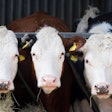The Maine Center for Disease Control and Prevention (Maine CDC) recently published important new data in the scientific Journal of Agricultural and Food Chemistry. The research comes from a study on the movement of per- and polyfluoroalkyl substances (PFAS) from soil into grass-based forages grown for livestock feed on contaminated land from the land application of wastewater sludge.
PFAS are a large family of chemicals sometimes referred to as “forever chemicals.” Results from this study will help guide efforts to reduce PFAS exposure at impacted farms and inform farm management decisions to help farms with contaminated soils remain a successful operation.
Food products such as cow’s milk and beef can be contaminated with PFAS at affected farms as the chemicals can move from soil into the animal’s feed grown at the farm and then can end up in the livestock.
Maine CDC toxicologists, along with community collaborators, conducted research on a Maine dairy farm with contaminated soil from historical land application of wastewater sludge, also known as biosolids. The team established several research plots and sampled soil and grass repeatedly over three years to better understand how much PFAS is transferred from the soil to the grass, known as “plant uptake.” The study focused on the chemical perfluorooctanesulfonic acid (PFOS) but also measured other PFAS present in the soil and grass. In addition to the research plots at the dairy farm, the study sampled soil and grass from fields on other Maine farms located in different regions of the state and with a different history of spreading biosolids.
Differences in PFOS plant uptake from contaminated soils discovered
PFOS uptake in grass-based forage samples differed tenfold among fields sampled on the same day on the same farm. The study also showed that the variability in PFOS uptake among fields on the same farm was not dependent on differences in commonly measured soil properties, such as percent organic matter, pH, or cation exchange capacity.
Higher PFOS uptake in grass-based forages was associated with higher soil levels of other PFAS known as precursors, which are PFAS that can be converted into PFOS. The study also revealed that PFOS uptake in a late summer second cut sampling of grass-based forage was, on average, twofold higher than uptake in an early summer first cut sampling.
Data to inform how to keep Maine farms in operation
The results from this study are already being used to inform Maine farm management decisions on impacted farms.
“These findings represent an important contribution to what is currently sparsely published data on the uptake of PFOS by an important forage crop for livestock,” said Tom Simones, assistant state toxicologist at the Maine CDC and lead author on the scientific paper. “These new data fill a major gap and will improve our ability to more confidently predict the movement of PFOS from contaminated soil into forage crops fed to livestock and the resulting levels of PFOS in foods such as dairy milk or beef.”
Future collaborations to expand research
Scientists at the University of Maine are undertaking further studies aimed at understanding the factors that cause the observed location differences in uptake of PFOS and other PFAS by grass-based forages. Maine CDC toxicologists, along with scientists at the University of Maine, are also studying PFAS uptake by corn crops used as animal feed.
A team effort
This study was made possible with the help of multiple state agencies and collaborators. Maine CDC staff would like to acknowledge the Maine Department of Agriculture, Conservation and Forestry for funding and assistance with sampling; the Maine Department of Environmental Protection for funding and staff assistance on sampling days; and the Broadreach Foundation for additional funding.
Collaborating scientists include Maine CDC State Toxicologist Andrew Smith, Chris Evans from the Maine Department of Environmental Protection, Caleb Goosen from the Maine Organic Farmers and Gardeners Association, Susan Genualdi and Wendy Young from the U.S. Food and Drug Administration, Center for Food Safety and Applied Nutrition, and Ellen Mallory and Richard Kersbergen from the University of Maine Cooperative Extension Service. The study was also made possible by the cooperation of Maine farmers allowing access to their lands for the study.


















